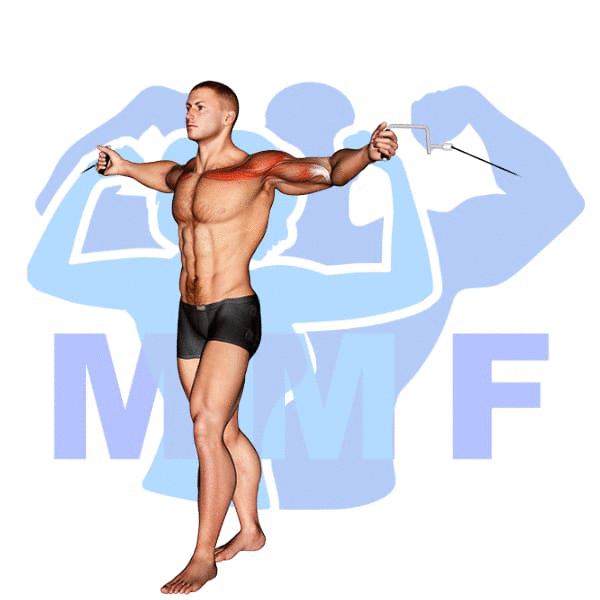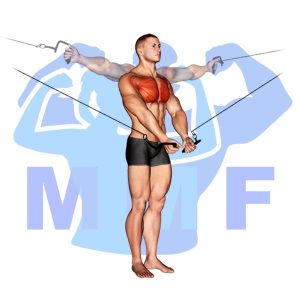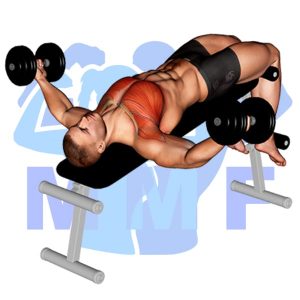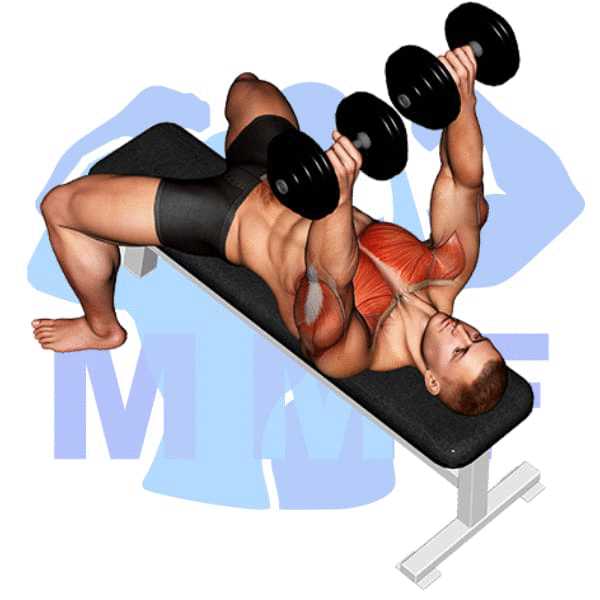Are you struggling to target your upper chest muscles? Are you tired of doing countless reps of the same exercise without seeing any significant improvement? One possible reason for this could be the lack of variety in your workout routine. It’s easy to fall into the trap of doing the same old exercises, day in and day out. But fear not, my friend! The cable incline fly is here to save the day. In this blog post, we’ll explore the benefits of the cable incline fly and how to perform it correctly to maximize muscle growth and definition in your upper chest. Get ready to take your chest workout to the next level with this powerful exercise.
Cable Incline Fly Summary
- Primary Muscles: Pectoralis Major – Clavicular
- Secondary Muscles: Biceps Brachii – Short Head, Deltoid – Anterior
- Equipment: Cable Machine with Two Single D-Handles
- Mechanics Type: Isolated
- Force: Push
- Utility: Auxiliary

Cable Incline Fly Instructions
- Attach two handles to pulleys opposite each other and set them at a height parallel to your chest.
- Grab a handle in each hand while standing in between the pulleys.
- While maintaining your torso erect, bend your elbows slightly while externally rotating your shoulders so your palms are slightly up.
- Next, pull the handles together in front and above your head while maintaining your elbows fixed.
- Return the handles out to the side by allowing the cables to stretch your chest back out a little.
- Repeat for these cable incline flys for a full set.
Video Tutorial
Cable Incline Fly Muscles
Target (Agonist)
- Pectoralis Major – Clavicular
Synergists
- Biceps Brachii – Short Head
- Deltoid – Anterior
Dynamic Stabilizers
- None
Stabilizers
- Hip Adductors (opposite)
Antagonist Stabilizers
- None

Benefits of Cable Incline Fly
The Cable Incline Fly is an excellent exercise for targeting the clavicular head of the pectoralis major muscle. Performing this exercise can help to improve the strength and size of this muscle, as well as help to improve shoulder and chest stability. Additionally, the Cable Incline Fly can also be used to correct muscular imbalances and postural issues, due to its ability to target the clavicular head of the pectoralis major muscle. The exercise also helps to activate the muscles of the upper back, aiding in posture and performance in other exercises.
Tips for Performing Cable Incline Fly
You’ve landed at the right location if you want to forge ahead your ability to perform cable incline fly. Using these suggestions can allow you to take full advantage of this amazing exercise. You can develop your chest muscles, and even reduce your risk of developing an injury. So let’s start now and discover what these tips may accomplish for you.
- Start slow: When beginning a cable incline fly, start slow and practice proper form to ensure you are doing the exercise correctly and maximizing your results. This will also reduce the risk of injury.
- Increase reps: Increase the number of reps as you become more comfortable with the exercise. This will help build muscle and increase your strength and endurance.
- Engage your core: Engage your core while performing the cable incline fly to ensure that your back is straight and you are using the correct muscles. This will help you get the most out of the exercise and maximize your results.
Benefits and Tips Video
Frequent Mistakes To Avoid
When performing cable incline fly, avoiding common mistakes can be the difference to achieving optimal results and avoiding injury. Additionally, to maximize your benefits of the exercise, proper form is required. Through preventing these common mistakes, you may improve your performance and get your desired results. But relax, it’s not as challenging as it might appear. By knowing the errors to avert and taking the appropriate actions, you can execute the exercise securely and successfully. So it is time for you to maximize your results from this exercise and enjoy the advantages of a successful workout.
- Not using proper form: It is important to maintain proper form during the exercise to ensure that the muscles are targeted correctly and to avoid injury.
- Using too much weight: Using too much weight can lead to strain on the muscles and increase the risk of injury. It is important to use a weight that is comfortable and manageable.
- Not stretching beforehand: Stretching before performing any exercise is essential to avoid muscle strains and ensure that the body is ready for the movement.
Find More Cable Exercises Here
Variations and Complementary Exercises
Below are several variations, complementary, or alternative exercises to the exercise Cable Incline Fly. These exercises are designed to target the same muscle groups as the Incline Fly, while providing some variation to your workout. Each exercise provides a slightly different challenge and can be used to add variety to your workouts.
Cable Decline Fly

The Cable Decline Fly is an effective alternative or complementary exercise to the Cable Incline Fly. It is performed on a decline bench with a cable machine. The exercise targets the chest and shoulder muscles, primarily the pectoralis major, deltoids, and triceps. To perform the exercise, the user will attach a single-handle cable attachment to the cable machine and set it at a low level. The user will then sit on the decline bench and grasp the handle with an overhand grip. The user will then lean back and bring their arms out to the side in a wide arc, before slowly bringing them back in to the starting position. The Cable Decline Fly is a great way to build strength in the chest and shoulders while also engaging the core and upper back muscles.
Cable Flys

Cable Flys are a great complementary or alternative exercise for the Cable Incline Fly. Cable Flys involve standing between two cables with a handle in each hand, and pushing your arms out to the side with control and then bringing them back together in front of you. This exercise works the chest muscles, but it also engages the shoulders, triceps, and even the lats and core. Cable Flys can be done at different angles, allowing you to target different areas of the chest. Because of its versatility, it is a great alternative to the Cable Incline Fly if you are looking to change up your workout routine.
Cable Low Fly

Cable Low Fly is a great complement or alternative exercise to the Cable Incline Fly. This exercise is performed by standing between two cable machines and then pulling the cables towards each other at waist level, with your arms fully extended. This exercise primarily works the chest muscles, but also targets the shoulders, triceps and core muscles. It is similar to the Cable Incline Fly, however, it is performed at a lower angle which can help to better engage the inner chest and shoulder muscles. It is a great way to add variety and challenge to your chest and shoulder workouts.
Check Out These Top Cable Exercises
Decline Dumbbell Fly

Decline Dumbbell Fly is an effective and complementary exercise to the Cable Incline Fly. The Decline Dumbbell Fly targets the lower chest muscles, while the Cable Incline Fly focuses on the upper chest muscles. This makes Decline Dumbbell Fly a great alternative or complementary exercise to the Cable Incline Fly. Decline Dumbbell Fly requires two dumbbells, which are held in each hand and then extended in an outward motion while lying flat on a decline bench. This exercise helps build strength and muscle in the lower chest area, as well as working the triceps and shoulders.
Decline Dumbbell Twist Fly

The Decline Dumbbell Twist Fly is a great alternative or complementary exercise for the Cable Incline Fly. It helps to target the same muscles as the Cable Incline Fly, but from a different angle. It also adds an element of instability which helps to engage the core and stabilizing muscles. To perform the Decline Dumbbell Twist Fly, you will need a decline bench and two dumbbells. Begin by lying on the decline bench with your feet firmly planted on the floor. Hold the dumbbells in each hand, and twist your torso to the right while extending your arms out to the side. Slowly lower the dumbbells towards the floor, and then twist back to the left and repeat the motion. This exercise is great for building strength in the chest, shoulders, and arms.
Dumbbell Fly

The Dumbbell Fly is an excellent alternative or complementary exercise to the Cable Incline Fly. This exercise focuses on the same muscles as the Cable Incline Fly, however, by using dumbbells, the weight is distributed more evenly than with a cable. Additionally, this exercise allows for a greater range of motion and variation in movement, allowing the lifter to focus on specific muscle groups. The Dumbbell Fly also provides a greater challenge to the core muscles, which are important for stabilizing the body during exercise.
Find More Chest Exercises Here
Opposing Complementary Exercises
It’s important to complete exercises that work the opposing muscle groups when doing the Cable Incline Fly. This will help ensure your muscles are properly balanced and prevent injury. Here are some exercises that can help you achieve this:
Dumbbell One Arm Row

The Dumbbell One Arm Row is an effective exercise for developing the back muscles, and it works in perfect harmony with the Cable Incline Fly. While the Cable Incline Fly works the pectoral muscles, the Dumbbell One Arm Row targets the opposing muscle group of the lats, rhomboids and traps. This combination of exercises helps to create a balanced physique by working both the pushing and pulling muscles of the upper body. Additionally, Dumbbell One Arm Rows can be performed in either a bent-over or kneeling position to target different muscle groups.
Seated V Bar Cable Row

The Seated V Bar Cable Row is a great exercise to complement the Cable Incline Fly. This exercise works the opposing muscle groups – the back and the chest. The Seated V Bar Cable Row primarily works the latissimus dorsi, rhomboids, and trapezius muscles, which are all back muscles. This exercise helps to strengthen and develop the back muscles, which are often neglected in most chest exercises. As a result, doing both of these exercises in tandem will help to create a balanced physique with more even development across both the chest and back muscles.
T Bar Supported Reverse Grip Row

The T Bar Supported Reverse Grip Row is a great exercise to complement the Cable Incline Fly. It works the opposing muscle group by targeting the lower lats and rhomboids, while the Cable Incline Fly works the upper chest and anterior deltoids. Both exercises work the core, however the T Bar Supported Reverse Grip Row puts more emphasis on the lower back muscles. This combination of exercises provides an excellent balance of both upper and lower body strength and helps to create a balanced physique.
Sculpt Your Chest with Cable Incline Fly!
If you’re looking to develop a more defined and muscular chest, the cable incline fly is a great exercise to add to your routine. By adjusting the incline of the bench and working with cables, you can effectively target your chest muscles from a variety of angles. Not only does this help to give you a more aesthetically pleasing physique, but it can also improve your overall strength and functional fitness. Make sure to include the cable incline fly in your next chest workout to experience its full benefits!
References: Wikipedia | ExRx.net | PubMed.gov | Comprehensive List of Chest Cable Exercises




